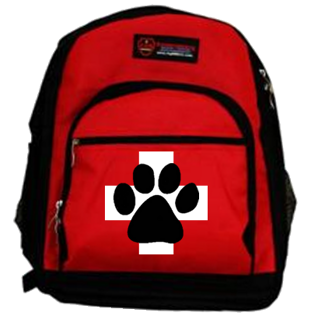Create a First Aid Kit for your Pets Before an Emergency Strikes
No one ever knows when an emergency will happen. The best thing is to always be prepared. Therefore, putting together a water-proof first-aid kit for your pets prior to an emergency is one of the best things that you can do as a pet owner. Many situations require fast action and prevention of further injury, infection or death. So assemble a first aid kit now, so that you'll be ready when your pet needs immediate help. Below is a listing of some items that you should include in your kit:

* An index card with emergency numbers such as:
* Animal Poison Control contact information
* Your pets regular veterinarian and local Veterinary Emergency Animal Hospital information
* Your own phone number
* Photos of your pets (to help identify them)
* Pet's health records
* Pet CPR instructions
* Your pets microchip number
* Flashlight & rubber gloves
* Scissors & tweezers (flat slant tip)
* Sterile needle (to remove splinters and tick heads)
* Turkey baster (for flushing wounds or force feeding)
* Eyedropper
* Tongue depressor to examine mouth
* Disposable safety razor (to shave fur around a wound)
* Towels (at least 2)
* Blanket (to keep an injured pet from going into shock)
* 3x3 sterile gauze pads & rolled gauze (for bandaging, stabilizing joints, making a muzzle)
* Anti-bacterial wipes or pads & Q-tips
* Ice pack
* Cotton balls and vet wrap bandages
* Hydrogen peroxide 3% USP (to use on infected wounds)
* Activated charcoal tablets (can absorb many toxics)
* Antibiotic ointment (such a Neosporin)
* Sterile saline eye solution (to flush out eyes and wounds)
* Milk of magnesia (for stomach upset and some types of poison ingestion)
* Pepto Bismol (for stomach upset and some types of poison ingestion; do not give to cats)
* Plain Benadryl (for bug bites and stings and other allergic reactions)
* Can of soft pet food (can reduce the effect of poisoning)
* Mild grease-cutting dishwashing liquid such as Dawn (to clean contaminated skin or sticky substances)
* Plastic baggies
* Muzzle and a nylon leash
* Bottled water & water bowl or container
* Adhesive first aid tape (in narrow and wide widths)
There are many more items that you can include. Please consult your vet for some additional ideas.
Immediate and proper first-aid is only the first step in the treatment of your pet. Please contact your veterinarian immediately and follow their instructions to ensure that your pet is well-cared for when a trauma has taken place. (Please consult your vet immediately before administering first aid.) |

